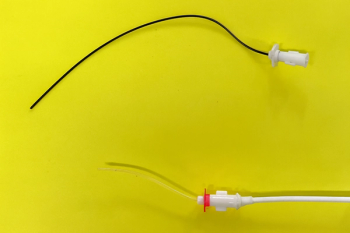
Diagnostic approach to lower urinary tract disease (Proceedings)
The clinical signs of many lower urinary tract diseases (LUTD) in dogs and cats are similar. Correct identification of the underlying disease process is critical to the development and implementation of a successful treatment plan.
The clinical signs of many lower urinary tract diseases (LUTD) in dogs and cats are similar. Correct identification of the underlying disease process is critical to the development and implementation of a successful treatment plan. The diagnostic approach to dogs and cats with lower urinary tract signs should depend on the pet's age and signalment, history and severity of clinical signs.
When assessing a patient with lower urinary tract disease, the signalment may be very helpful in narrowing the list of possible etiologies. For example, younger cats are more likely to have idiopathic lower urinary tract disease, while this disease occurs much less commonly in cats greater than 10 years of age. Sex is important in that female patients are more likely to have bacterial urinary tract infections, etc. Knowledge of breed predispositions to specific lower urinary tract disease will also help to focus diagnostic efforts. For example, Bichon's are predisposed to developing calcium oxalate stones, male Dalmatian's are predisposed to developing urate stones, and older Scottish terriers have a predisposition for transitional cell carcinoma of the bladder.
A complete and detailed history from the owner is very important in establishing a diagnosis. Along with the chief complaint, it is imperative to obtain information about the past and present history, including environment and diet. Specific questions should focus on the patients' general attitude and activity level, water consumption, frequency and pattern of urination, abnormalities in the smell or colour of the urine, any other system abnormalities. Additionally, information about all previous treatments and response to therapy should be obtained. Common presenting complaints of patients with lower urinary tract disease include stranguria, pollakiuria, hematuria, and inappropriate urination. Although inappropriate urination may be a behavioural issue, especially in cats, this should be a diagnosis of exclusion and all medical causes should be investigated.
A thorough physical exam, including visual inspection of the external genitalia may also be helpful in localizing the problem. Perineal dermatitis and/or wetness could indicate urinary incontinence. Abdominal palpation may be used to assess bladder size and turgor. Palpation of the abdomen may also be helpful in identifying pain. Transrectal palpation of the urethra can be used to detect urethroliths, urethral tumors, urethral tone, and prostatic disease, all of which can contribute to lower urinary tract signs.
Diagnostic Evaluation
The typical initial minimum database for any patient presenting for lower urinary tract signs includes a detailed history, physical exam, urinalysis, urine culture and survey abdominal radiography. More extensive laboratory evaluations including complete blood count and serum chemistry panel should be considered for older animals or patients with comorbid conditions. Additional diagnostic testing such as ultrasound, contrast radiography, or cystoscopy should be considered in patients with persistent or chronic signs or in those that have not had the expected clinical response to previous therapies.
Urinalysis
A complete urinalysis is essential when evaluating the lower urinary tract. Under most conditions, cystocentesis is the preferred method of urine collection for diagnostic and therapeutic evaluation. Cystocentesis provides samples free of vaginal and preputial contaminants and has few adverse side effects. If the urinary bladder is difficult to palpate, ultrasound can be used to guide the cystocentesis needle into the bladder lumen.
Although cystocentesis is the preferred method of urine collection for examination of urine, there may be times when a free catch sample is preferred. For example, if disease of the prostate or urethra is suspected, a free catch sample may provide more information. When possible, the first part of the urine stream should be excluded from the sample submitted for analysis because it may be contaminated during contact with the genital tract, skin, and hair. Voided samples are usually unsuitable for bacterial culture.
Most diagnostic reagent strips used to perform routine urinalysis in veterinary laboratories have been designed for human use. Although these reagent strips provide useful information when used to evaluate urine samples collected from animals, test results obtained with several diagnostic urine strips are unreliable. The following list summarizes limitations of most reagent strips, and suggestions to minimize them.
Table 1: Limitations of Urine reagent strips (urine "dip-sticks") in dogs and cats.
In addition to the reagent strip, a complete urinalysis should include a urine specific gravity obtained from a refractometer and a microscopic urine sediment exam. A standardized approach to the urine sediment exam will provide consistent and reliable results and aid in establishing a proper diagnosis.
Table 2: Procedure for Urine Sediment Exams
Urine Culture
Urine culture is the most accurate way of diagnosing a urinary tract infection. In addition, results of a properly performed urine culture and antibiotic sensitivity test will guide appropriate antibiotic selection. It is important that urine be collected for urine culture prior to the administration of antibiotics. Bacteria are usually not detected by urine sediment examination until concentrations exceed at least 10,000 organisms per milliliter of urine. Likewise, the number of leukocytes in urine is variable and may be blunted in patients with hyperadrenocorticism, those receiving corticosteroids, those producing alkaline urine, and those producing dilute urine. Bacteria may be falsely indentified in urine sediment viewed with stains that have become contaminated with bacteria or with stains that contain precipitated debris. To ensure appropriate diagnosis and treatment, culture urine for aerobic bacteria when diagnosing or monitoring bacterial urinary tract infections.
Survey Abdominal Radiography
Abdominal radiography is an important diagnostic tool when initially assessing patients with lower urinary tract diseases. Uroliths are among the most common cause of lower urinary tract signs in both dogs and cats and the most commonly encountered stones are radio-opaque. In addition to identifying urolith location, radiographs also help to confirm their size, shape and number. Survey abdominal radiographs are also very useful when assessing bladder size and location, and provide a global assessment of the abdomen and spinal column for changes that could impact urinary tract function. More advanced contrast procedures may be used to assess for radio-lucent uroliths, structural and mucosal irregularities. Fluroscopy may also be used to provided dynamic evaluation of the urethra.
Uroendoscopy
Patients with lower urinary tract disease displaying unusual, prolonged or refractory clinical signs, should be further evaluated with urethrocystoscopy. Uroendoscopy is a very useful, minimally invasive technique for diagnosis and often management, of lower urinary tract diseases in dogs and cats. Urethrocystoscopy enables direct examination of the vestibule, vagina, urethra and bladder, often providing the diagnosis. In addition to direct visualization of the lower urinary tract, uroendoscopy may also be used for more advanced diagnostic and therapeutic procedures. Some diagnostic and therapeutic indications for uroendoscopy are outlined in table 2.
Table 3: Diagnostic and therapeutic indications for uroendoscopy
Newsletter
From exam room tips to practice management insights, get trusted veterinary news delivered straight to your inbox—subscribe to dvm360.




